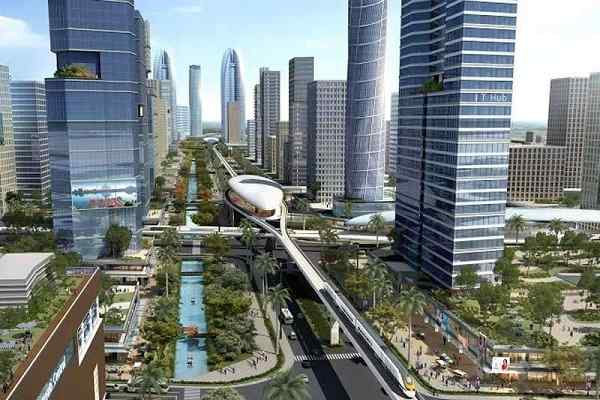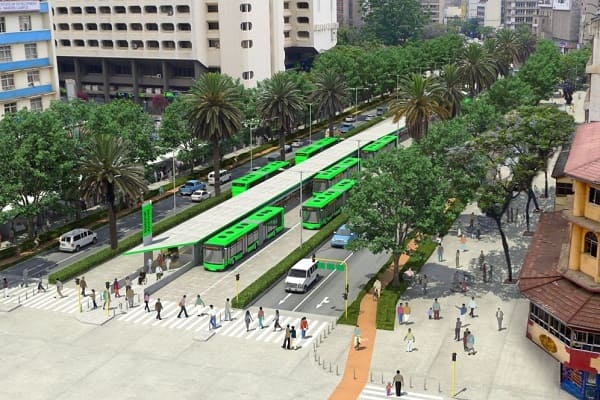 Delhi unveils ambitious Urban Mobility Vision: Luxury Metro Coaches, New Tunnels and Pod Taxi
Delhi unveils ambitious Urban Mobility Vision: Luxury Metro Coaches, New Tunnels and Pod Taxi Qatar approves Saudi Rail Link Agreement, Accelerating Gulf Railway Vision 2030
Qatar approves Saudi Rail Link Agreement, Accelerating Gulf Railway Vision 2030 UP Govt plans to introduce Water Metro services in Ayodhya, Varanasi & Prayagraj
UP Govt plans to introduce Water Metro services in Ayodhya, Varanasi & Prayagraj India’s First Urban Ropeway begins Trial Run in Varanasi, Set to carry 1 Lakh passengers daily
India’s First Urban Ropeway begins Trial Run in Varanasi, Set to carry 1 Lakh passengers daily India and Bhutan to Build First-Ever Rail Link: ₹4,033 Cr Project to Boost Regional Connectivity
India and Bhutan to Build First-Ever Rail Link: ₹4,033 Cr Project to Boost Regional Connectivity Patna to launch Eco-Friendly Water Metro; Trial Run soon between Digha and Kangan Ghats
Patna to launch Eco-Friendly Water Metro; Trial Run soon between Digha and Kangan Ghats Air India Group set to launch Flights Operations from Navi Mumbai International Airport
Air India Group set to launch Flights Operations from Navi Mumbai International Airport Chennai to launch 25-Year Mobility Plan with Unified QR Ticketing and One-App Transit System
Chennai to launch 25-Year Mobility Plan with Unified QR Ticketing and One-App Transit System Kochi Metro bags ₹4.4 crore contract to prepare DPR for Mumbai Water Metro Proejct
Kochi Metro bags ₹4.4 crore contract to prepare DPR for Mumbai Water Metro Proejct Navi Mumbai International Airport set for September launch; IndiGo and Akasa Air to lead Operations
Navi Mumbai International Airport set for September launch; IndiGo and Akasa Air to lead Operations
A smart city must also be a safe city, with a good disaster response system

New Delhi: A smart city must also be a safe city, with a good disaster response system. With the implementation of the Smart Cities Mission moving forward in a phased manner and technology forming the backbone of smart cities’ architecture and governance, one of the major challenges identified for the future is cybersecurity. “There cannot be a smart city before it being a safe city, with a good disaster-response system,” says Claudio Simao, Chief Technology Officer, Hexagon AG, a Sweden-based leading solutions provider for smart cities. His observation sums up the importance of making the upcoming 100 Smart Cities under the National Mission secure physically and in the cyber world.
Threatening landscape: In fact, integrated technologies assist in the efficient delivery of services and there is optimism about their constructive impact on our cities. However, the more technology you use, the higher the threat of it being compromised. Cyber attacks, which earlier targeted data centers, are now directed towards numerous systems and devices spread across a smart city. A single intrusion may leave the entire smart city network compromised. Hence, connected IoT (internet of things) devices need to be protected, including software, hardware, and data.
Smart cities would need to be geared towards insulating huge networks that are bound to become the nerves of the city. Says NSN Murty, PWC Partner, Smart Cities, “Technology forms the core of the Smart Cities Mission. If that is progressing well, we are on the right track. Sensitizing our cities on how to use technology for effective governance is the first step to achieve the end goal.” In a report brought out by PWC, in association with Data Security Council of India, Rama Vedashree, CEO of DSCI, notes, “While the Smart City initiative focusses on sustainable development of our cities and harnessing digital technologies for an integrated citizen-services delivery, it demands a strong focus on cybersecurity.”
“Globally, countries have deployed technologies and controls to avoid loss of data, network lock-down and stalling of critical services that can otherwise cripple a city’s functioning. We also need to take appropriate measures to create cyber-secure smart cities......” she adds. The Indian Smart City technology architecture is based on four logical layers of sensors, communication, data, and application layers. The technology across these four layers works in an integrated manner to deliver smart city services.
However, the ground analysis of a few smart cities suggests that the technology powering them is prone to vulnerabilities, which can lead to potential social, health, economic and reputational risks. The potential for challenges, lack of granular guidelines and regulations and India-specific issues add to the complexity of the risk landscape for Indian smart cities.
Enhanced budget The significance of the Smart Cities Mission can be judged from the fact that its allocation was doubled during Budget 2018-19 to ₹2.04 lakh crore. “All hundred cities have been declared and now we are beginning to see the physical manifestation of the city strategy proposals on the ground. Cities took some time to adapt and understand the novel design of the mission given its governance structure, funding mechanisms and convergence with other urban missions,” Murty says. However, while smart cities promise an improved quality of life for which they intend to utilize technology, the threat vulnerability of its use must be factored in.
This has been recognized globally since there are examples of cities being brought to a halt because technology and data systems were compromised The Smart Cities Mission in India could also face such challenges throughout the mission process. The fact that there is no universally accepted definition of a ‘smart city’ is possibly what allows such cities around the world to set their own agenda while laying down the guidelines for their initiatives. Smart cities, therefore, have the freedom to develop their own strategies based on local factors like demographics, geography, economy, and heritage, among others. This makes sense because what works in one city may not work for another — so what is perfect for Barcelona may not be effective in Varanasi.
Going back to how India has progressed so far in the implementation of smart cities, Murty feels we need to be conscious of the fact that the last nine out of 100 smart cities were declared in January 2018. It is unrealistic to expect all smart cities to be at the same level. “Cities like Bhopal, Nagpur, Surat, Vadodara, Pune have done extremely well in executing their projects. The cities declared in later rounds need to leverage knowledge and learnings from these cities to hit the ground running.
Eighty-seven out of 100 cities have appointed project management consultants, so we can expect them to roll out projects very soon,” he says. Pratap Padode, Founder Director, Smart Cities Council of India, points out that the Mission has completed three years and is work in progress. Currently, works worth ₹8,000 crore have been completed and 1,200 projects costing ₹50,000 crore tendered. Also, 98 projects worth ₹6,000 crore are under implementation under public-private partnership mode. Credit rating has been completed for 412 cities, of which 155 cities have proven to be investment grade.
Currently, Padode says “Eleven Integrated Control and Command Centres are installed at Ahmedabad, Kakinada, Visakhapatnam, Nagpur, and Pune, among others. Twenty-one cities have called for tenders for ICCC. CCTV installations are helping cities get cleaner due to monitoring and technology is being deployed in road construction, property tax management, water management, and waste management.” The last, he feels, is a big challenge, which is being sought to be addressed by ‘waste to energy’ plant proposals.
Sridhar Gadhi, CEO of Quantela Inc, a technology solutions provider who offers artificial intelligence-based solutions for over 40 cities globally, gives an example of smart infrastructure — a smart pole that combines the benefits of LED lighting, Wi-Fi connection, surveillance cameras, and mobile connectivity. He too flags the security aspects over all else. “It is the right time now to work on security aspects as protection of digital assets will become central to upcoming cities,” he emphasizes. And that is what is happening. From merely developing smart cities, the focus is shifting to cyber-secure cities with a robust framework.







